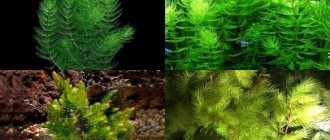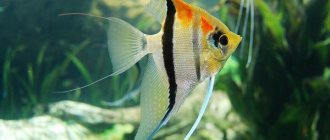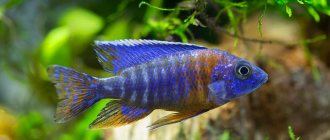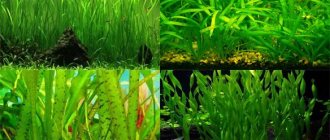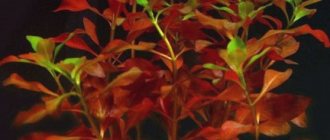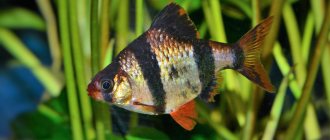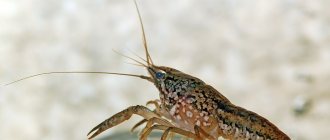Description
The hornwort plant is a rhizomeless species. It lives in the water column and rises to the surface. Sometimes it clings to supports with stem shoots-rhizoids and absorbs substances necessary for development from the silt. The dissected leaves are divided into thread-like plates resembling a spruce branch. Looks attractive in any size aquarium.
If you look through a microscope, you can see small teeth. Nutrition is produced by all cells on the surface of the plant, covered with a fat-like film. Color ranges from light green to brown. Survives at temperatures of 6…30°C.
It blooms with petalless corollas up to 0.2 cm long, which when ripe resemble nuts. It contains tannin, a bitter-tasting substance, so aquatic algae lovers do not touch it.
Application
Hornwort can be used to green up your home aquarium quickly and inexpensively. This primarily concerns beginners who cannot provide comfortable conditions for more demanding plants.
In addition to decoration, it is used as plant food for some aquarium fish. Fry and shrimp love to hide in it. The plant is placed in spawning tanks.
The plant is also allowed to float on the surface of the water to shade shade-loving plant species, such as anubias and cryptocorynes. In aquariums without a lid, hornwort floating on the surface of the water prevents the fish from jumping out of the aquarium.
Kinds
There are several dozen species of hornwort found in nature, the descriptions of which differ in the structure and color of the leaf apparatus.
The following types are common in home aquariums:
- Hornwort submerged. A characteristic difference is dark green foliage. The stem is long, branching. Feels good in slightly alkaline, moderately hard water. Under natural conditions, the perennial lives in water up to 9 m deep. It has a high degree of vitality and is capable of cleaning water well from dirt.
- Hornwort semi-submerged. The color of the “needles” ranges from light green to red. Delicate and fragile, grows on a long stem. It looks impressive in an aquarium, planted along the back wall. Under normal conditions it can grow up to 20 cm in a week.
- Cuban hornwort is very decorative due to the fluffy dark green leaves and bright red stem. It is distinguished by an unusual color combination and a shape that resembles a bunch of grapes. Prefers good lighting, which helps it create short internodes and a dense leaf cluster. Having reached half a meter, it begins to branch. With a lack of lighting, the growth rate decreases. Valued for its strong shoots that are not prone to breaking off.
- Mexican hornwort is one of the most unpretentious. Looks like the classic dark green (submersible) hornwort. The stem is dark brown, and the side shoots grow in pairs. Each plate is bifurcated. It floats freely on the surface and can settle on the bottom.
Attention! The least commonly found on sale is the semi-submersible one with light green leaves due to its fragility and difficulty in transportation.
Benefits for the aquarium
Hornwort in an aquarium is not only a successful ornamental plant, it performs the function of a continuously working biological filter. Collects and processes waste products of aquatic inhabitants and dead organic matter. This is his main merit.
The plant is recommended to be grown for the following reasons:
- Excellently “pulls out” nitrates, which are the end product of the nitrogen cycle.
- Thanks to its ability to release oxygen, the fish feel better and the fry develop quickly.
- Caviar sticks well to the needle-shaped algae leaves, which contributes to successful throwing.
- Tiny aquarium inhabitants feel safe in dense branches.
This useful aquatic plant significantly improves the condition of the aquarium and accelerates the adjustment of biological balance.
The naiad is often confused with the elodea plant.
Both Elodea and Egeria nayas belong to the same family - water-colored, they are very similar in appearance. However, Elodea (Elodea canadensis, “water plague”) is a cold-resistant plant. As the name suggests, it came to Europe and Russia from Canada and took root well in our cold water bodies, in a short time filling them so much that it became an obstacle to shipping. While Egeria nayas, like other representatives of the species, is thermophilic.
The herbs Egeria naias and elodea are easy to distinguish: the latter has slightly wider leaves, without teeth (naiad has very small teeth, but you can feel them by running your finger along the edge of the leaf). In addition, during the winter, Elodea dies off even in an aquarium, while nayas remains green all year round.
Keeping in an aquarium
Hornwort does not have a root; absorption of nutrients occurs over the entire surface. Therefore, it does not matter to him what type of soil. The plant is unpretentious, but you should not test its strength, but give it the opportunity to fully perform its cleansing function. It is important to provide the plant with 10 hours of daylight without direct sunlight and warm water.
How to care
Conditions in which aquarium hornwort feels best:
- It is advisable to place large driftwood or stones on the bottom and secure the plant.
- It will not die at 5°C, but active development and bright color can be expected at a temperature of 20…24°C.
- The size of the aquarium must correspond to the degree of growth, since the plant can quickly fill the space. Recommended volume: 100 liters.
- Aggressive sun rays are harmful to most aquatic inhabitants, including hornwort.
- Under artificial lighting, the power of a fluorescent lamp should be 0.4 W/l.
- Aeration and filtration can be used at medium or low power, and the flow can be directed in the other direction.
The level of nitrates affects the condition of the green hornwort, but additional fertilizer is not necessary. Once a week, a fifth of the water volume should be renewed. This helps maintain the pH at 5.5.
This is interesting! Snails love to eat algae, but they won’t touch hornwort because of its bitter taste.
Reproduction
Breeding is easy. To get a new “seedling”, you need to break off a young shoot and let it float freely. Sometimes the stems separate on their own. Hornwort can be propagated through cuttings. It is required to divide the main stem into parts. Each segment will develop independently if the water is provided at room temperature. During the process of vigorous growth of shoots in favorable conditions, the owner of the aquarium needs to ensure that they do not fill the entire container.
How to fix hornwort in an aquarium
Plants that are fixed to the bottom look more aesthetically pleasing. Therefore, aquarists try to create the hornwort in the form of a bush growing from the ground, although the plant itself does not need this. You can “plant” hornwort as follows:
- wrap the stem around a transparent rod and secure it at the bottom with a tourniquet;
- use stones with holes as “anchors”;
- secure with fishing line to the snags.
You can plant hornwort in an aquarium in any way, but it is important to know that it will grow in a short time. It is necessary to work as a gardener and adjust the composition. The lower stem of the plant is sometimes cut off, as it turns yellow and becomes bare.
Why does it turn yellow and not grow?
There are situations when the hornwort in the store has grown over the entire aquarium, and when moving to a new place of residence it turns yellow or drops its leaves.
The reasons may be as follows:
- large differences in the indicators of the aquatic environment in the new and old aquariums (temperature, acidity, hardness);
- direct exposure to sunlight;
- unsuccessful transportation (long journey with lack of moisture, hypothermia);
- Nitrate levels are too low.
Before adding hornwort to an aquarium, you need to think about the conditions of its maintenance and carefully transport it in a container with water, protecting it from low temperatures.
What to do if the hornwort is sick
The plant practically does not get sick. When a fungal infection develops in an aquarium that threatens the well-being of its inhabitants, it is removed and washed under running water. Then they are treated with a solution of manganese and deposited in a separate container. Keep there until the aquarium is free of harmful microorganisms. Stems yellowed by the sun are cut off.
Breeding
Elodea is propagated by cuttings. For planting to be successful, it is enough to break off a cutting from the mother plant and place it in a new aquarium. There is no need to care for the plant during this period. Egeria easily reproduces by simply floating in water, but it will still be more comfortable for it to grow in the ground. To choose how to plant a plant, you need to estimate the volume of the aquarium and also adhere to the list of rules:
- It is prohibited to transplant a new cutting into an inhabited aquarium, since at first the juice found on the cut of algae is poisonous to fish;
- For a successful transplant, it is important to pay attention to the plant variety, since the temperature values recommended for propagation may differ;
- It is advisable to line the bottom of the aquarium with coarse river sand, this will make it easier for the plant to adapt to new conditions;
- It is better to determine the place of settlement at the back wall of the aquarium.
Green elodea placed in an inhabited aquarium will not only be a useful attribute for cleaning it, but also a beautiful addition to the decor!
Price
This type of algae is one of the most common and has a low price. Sold in a pet store that sells products for aquarists. Dark green hornwort is often available for sale. The average price is 30 rubles. for a bush. It grows very quickly, so it is enough to purchase one copy. If the bush is lush, you can immediately divide it. Redstem is less common and costs a little more.
A perennial aquatic plant will grow in an aquarium for many years if the minimum maintenance requirements are met. Hornwort can significantly improve the condition of the microflora of the aquarium and provide a good service to fry, crustaceans and catfish that like to hide in green thickets. Beginning aquarists should not be afraid to purchase this type of algae, since the care is minimal and the returns are high. Leave comments and share the link to the article on social networks.
Part 2: Aquarium Christmas trees
We continue the conversation about long-stemmed aquarium plants, which are used to decorate the background and sides of the aquarium.
The plants that will be discussed today have, in fact, only one thing in common: the shape of the leaves, which is why they have received the collective name “fir trees” or “horsetails” among the people. Indeed, deeply dissected pinnate leaf plates in combination with a vertical stem create just such a cozy New Year’s image of “aquarium trees”.
In fact, outwardly similar “Christmas trees” not only come from different continents, but also belong to completely different families and genera. Cabombas grow in North and South America and belong to a separate family Cabombaceae, which, in addition to five species of cabombas, includes another amazing aquatic plant, found in our Far East and listed in the Red Book of the Russian Federation - Brazil, whose appearance and leaf blades resemble a nymph, and flower - cabomba. Limnophils (Ambulia) are Asian plants, more than forty species of which are found in fresh water bodies of India, China, Sri Lanka, and Southeast Asia. The genus Limnophila belongs to the Podorozhnikov family (although on aquarium websites and in the literature they still write “the Norichnikov family,” which is incorrect). Occupying identical ecological niches in similar biotopes in terms of parameters, respectively, in America and Asia, these plants are so similar in appearance that often on aquarium forums on the Internet there are questions: “Help me determine which is growing on me - cabomba or ambulia?” By the way, it is quite simple to distinguish them: cabomba has no more than 2-4 strongly dissected leaves in each whorl, while ambulia can have a dozen of them. And the stem of limnophilas is much thicker than that of cabombas. But the “dill” leaves of both plants are really similar. Both groups of “water fir trees” are extremely aesthetically pleasing in the aquarium, and with skillful care they become very beautiful. But each of these species has its own characteristics and secrets...
